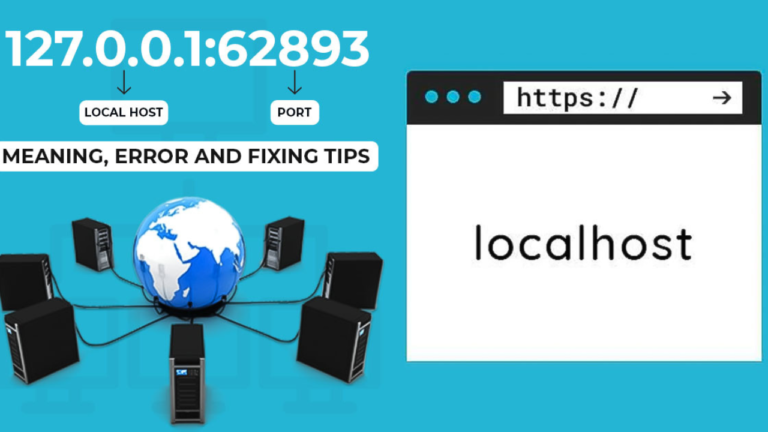In networking, combining an IP address and a port number is critical for local communication, particularly during the development and testing phases. One prominent example is the address 127.0.0.1:62893, where 127.0.0.1 refers to the local host (loopback address), and 62893 represents a specific port number. This article aims to delve into the significance of this address combination, its applications in various contexts, and essential security considerations.
Understanding Localhost (127.0.0.1)
Localhost is a term widely used to describe the local computer that one is currently using. The IP address 127.0.0.1 is reserved for the loopback interface, which allows a computer to communicate with itself. This setup is crucial for developers, enabling them to run tests and debug applications in a controlled environment without exposing the software to external networks. By using localhost, developers can ensure their code functions correctly before deployment, minimizing risks associated with live environments.
The Role of Ports in Networking
A port serves as a communication endpoint within a network, helping to direct traffic to specific applications running on a machine. Ports are categorized into three types:
- Well-Known Ports (0-1023): Used by standard protocols such as HTTP (port 80) and HTTPS (port 443).
- Registered Ports (1024-49151): Assigned to user services or applications.
- Dynamic/Private Ports (49152-65535): Typically used for temporary purposes or custom applications.
In this context, port 62893 falls into the dynamic/private category. Although not linked to any standard service, this port is often utilized in development environments for testing and debugging applications.
Analyzing Port 62893
Port 62893 is commonly employed for various local development activities, such as servers or applications requiring a temporary communication channel. For instance, when developing a web application, a developer might configure a local server to run on 127.0.0.1:62893, allowing them to test functionality without affecting external systems. This arrangement is particularly beneficial for custom applications, where developers can avoid conflicts with standard ports.
Everyday Use Cases for 127.0.0.1:62893
- Web Development: Developers often utilize localhost to run local development servers, ensuring their applications work as intended before going live.
- Database Management: Local databases can be accessed via the loopback address, facilitating seamless testing and debugging of database queries.
- Network Application Testing: By simulating client-server interactions on localhost, developers can stress-test their applications and analyze traffic patterns without external interference.
- Security and Penetration Testing: Using 127.0.0.1 allows security professionals to set up honeypots and test configurations securely.
Security Considerations
While using 127.0.0.1:62893 provides a degree of security by limiting access to the local machine, several precautions should still be taken:
- Limiting Access: Services on the loopback address are not exposed to external sources by default. However, they could become vulnerable if misconfigured to listen on all interfaces.
- Monitoring Services: Regularly monitoring local services can help identify potential vulnerabilities. This includes checking for unusual traffic patterns that may indicate misconfigurations or security issues.
- Firewalls and Security Software: Implementing robust firewall rules and security measures can help prevent unauthorized access to sensitive applications even when operating on local hosts.
Troubleshooting Issues with 127.0.0.1:62893
Developers may encounter various issues while using 127.0.0.1:62893, such as:
- Port Already in Use: If a service occupies port 62893, developers must terminate that service or choose a different port.
- Connection Refused: This error occurs when no service is listening on the specified port. Ensuring the service is up and running is crucial.
- Firewall Settings: Local firewalls may block access to specific ports. It is essential to check firewall configurations to allow traffic through port 62893.
Best Practices for Using 127.0.0.1:62893
To ensure the effective use of 127.0.0.1:62893, developers should adhere to the best practices:
- Use Environment Variables: Instead of hardcoding port numbers, leveraging environment variables can enhance flexibility in the application configuration.
- Implement Error Handling: Robust error handling mechanisms can facilitate quick identification and resolution of issues during development.
- Document Usage: Thoroughly documenting configurations related to 127.0.0.1:62893 can aid in future maintenance and onboarding of new developers.
- Regular Audits: Periodically reviewing which services are active on various ports can help maintain a clean development environment.
Conclusion
Understanding 127.0.0.1:62893 is vital for developers and system administrators alike. Its unique position as a loopback address combined with a specific port allows for a controlled, secure environment for testing and debugging applications. By effectively utilizing localhost and adhering to best practices, developers can enhance their productivity and ensure the reliability of their applications before they are deployed in live environments.
This insight into local host networking and port usage streamlines the development process. It reinforces the importance of security in a digital landscape where unauthorized access can lead to significant risks.
Read More: When Doubled a Mild Reprimand: Exploring the Consequences of Heightened Feedback.


